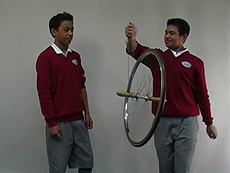On Yer Bike | He Wīra Hurihuri
Introduction
Abstract
A spinning bicycle wheel balances like magic while dangling from a string. The spinning wheel also causes a student to spin on a rotating stool.
Principles Illustrated
Conservation of angular momentum. Torques. Gyroscopes.
Content
Video
English version
Instructions
This is probably the single most valuable physics demonstration one can do at a school. Suitable wheels can be purchased from various sources. The spinning seat is more expensive and difficult. Ours is portable with some effort.
Have students dangle the spinning wheel by a string and hold the spinning wheel in their hands to feel how difficult it is to tip it over.
About riding a bicycle
The “balancing” of a bicycle has traditionally been explained in terms of the angular momentum of the spinning wheel (the “gyroscope” effect). Some examples:
- http://hyperphysics.phy-astr.gsu.edu/hbase/bike.html
- http://science.nasa.gov/headlines/y2006/30nov_highorbit.htm (see the appendix under “more to the story”).
- http://www.physics.ucsb.edu/~circus/momentumdemo.htm
But it is possible to ride a bicycle that has counter rotating wheels and therefore no angular momentum. See for example http://ruina.tam.cornell.edu/research/topics/bicycle_mechanics/stablebicycle/index.htm and references included in that article. So, while the angular momentum will certainly affect the handling of the bicycle and allows the bicycle to travel upright with no rider, it does not actually play a key role in your balancing while riding a bicycle.

Other Information
Safety
Watch the fingers in the wheel! Also, we recommend a sturdy, heavy spinning seat that has a seatbelt.
Individual teachers are responsible for safety in their own classes. Even familiar demonstrations should be practised and safety-checked by individual teachers before they are used in a classroom.
Credits
This teaching resource was developed by the Te Reo Māori Physics Project with support from
- Te Puni Kōkiri
- The MacDiarmid Institute
- Faculty of Science, Victoria University of Wellington
- School of Chemical and Physical Sciences, Victoria University of Wellington
- The New Zealand map shown on the poster frame above is used with permission from www.nz.com.